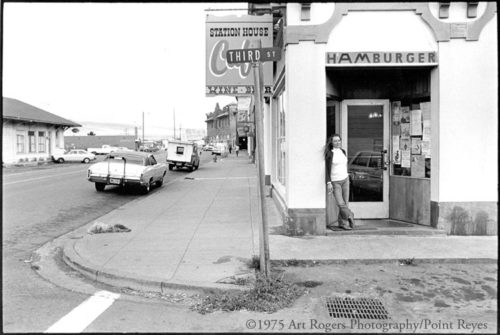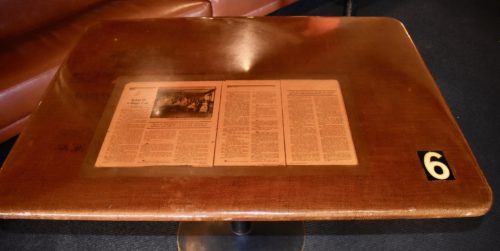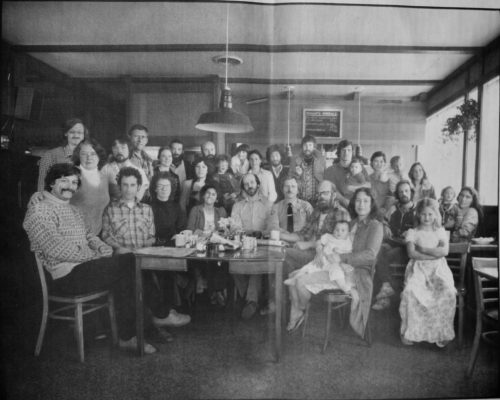Caveat lectorem: When readers submit comments, they are asked if they want to receive an email alert with a link to new postings on this blog. A number of people have said they do. Thank you. The link is created the moment a posting goes online. Readers who find their way here through that link can see an updated version by simply clicking on the headline above the posting.
The closure of the Station House Café, scheduled for the end of this month, will be the closing of not only a restaurant but also of the meeting ground for many West Marin residents. Last week, I republished Jack Mason’s column set in 1966 when he owned the restaurant while also contributing to The Baywood Press, as The Point Reyes Light was then called.

Pat Healy once told me that before she added the “Station House Café, Wine-Bar” sign, the only identification on the building was the word “HAMBURGER.”
Mason eventually sold the restaurant to Claudia Woodward, who in 1974 sold it to Pat Healy, a former nightclub singer who had moved to Point Reyes Station in 1972. The café quickly became popular, and in 1980, California Living (a magazine that came with the Sunday San Francisco Examiner-Chronicle) noted the Station House is “the heart of the West Marin community, and “an institution known as Table 6 is the heart of the Station House.” I remember that table well.
The piece written by George Nevin added that Table 6 “is actually two burlap-and-acrylic tables pushed together between the piano and the reach-in refrigerator. Here of a morning can be found the damndest bunch of regulars to be seen anywhere.

Table 6 with Nevin’s article lacquered onto it moved, along with the rest of the restaurant, from the building where Osteria Stellina is today to its present location in 1988-89.
“It’s the same crew, day after day, fog or shine, six days a week,” wrote Nevin. “It would be seven days, but the Station House is closed Tuesdays. Regulars include the following: Dave Mitchell, who copped both a Pulitzer Prize and Publisher of the Year award last year for his Synanon coverage; Art Disterheft, West Marin’s beloved sheriff’s lieutenant, who is a prizewinning cook, holds a law degree, and is building his own house out of salvaged lumber; Allan Ruder, the town pharmacist who peddles T-shirts that say, ‘I Get My Drugs at West Marin Pharmacy’; Art Rogers, the town’s photographer laureate, who somehow has become an artistic success that reaches far beyond this cow town; Elizabeth Whitney, who once challenged publisher Mitchell with a rival weekly, The Tomales Bay Times, and who is likely to fly off to the ends of the earth in search of a good solar eclipse (she just got back from an eclipse trip to Kenya).
“That’s not all Table 6 has to offer. There are many others of perhaps less renown but no less important to the town: the hippie mechanic who has visions of opening a Mercedes dealership in Point Reyes and easing into semi-retirement; the man with a PhD in psychology who now pounds nails for a living; a fellow who drives possibly the most beat-up Volkswagen in West Marin, who lives in what appears to be genteel poverty but who, they say, has storage bins of exotica like antiques and espresso machines throughout the Bay Area; the skilled workers in stained glass, cabinetry, and windows.

Table 6 regulars, café staff, and friends on a Monday morning in April 1980. The Point Reyes Light last week published this Art Rogers photo in announcing the upcoming closure. Pat Healy is third from the left. This is the same photo that California Living had published with Nevin’s article 40 years earlier.
“The conversation of a morning covers an astounding range, from financial matters to science, politics, religion, computers, military matters, education and law. There’s nothing they won’t touch, nothing sacred, hardly anything so esoteric that someone doesn’t have some intimate knowledge of it. And when breakfast is over, they scatter to their jobs making useful things, creating, contributing to what photographer Rogers calls the Point Reyes Nation.”
In 2005, Healy sold the restaurant to its manager, Sheryl Cahill, but retained ownership of the building. Healy died on Dec 8 at the age of 92 and left the building to her stepsister, Melinda Benedict, and two stepchildren, Kirsten and John Hural. The new owners now want to raise the rent from $100,000 per year to $252,000 per year. Cahill says that’s more than the restaurant can afford, which is why it will close. However, she hopes to reopen somewhere in the area. Anyone who knows a suitable building ought to contact her. The Station House has long had good food and drinks, as well as having good music in the bar on Sunday evenings, but its role as a community meeting place is just as important.
